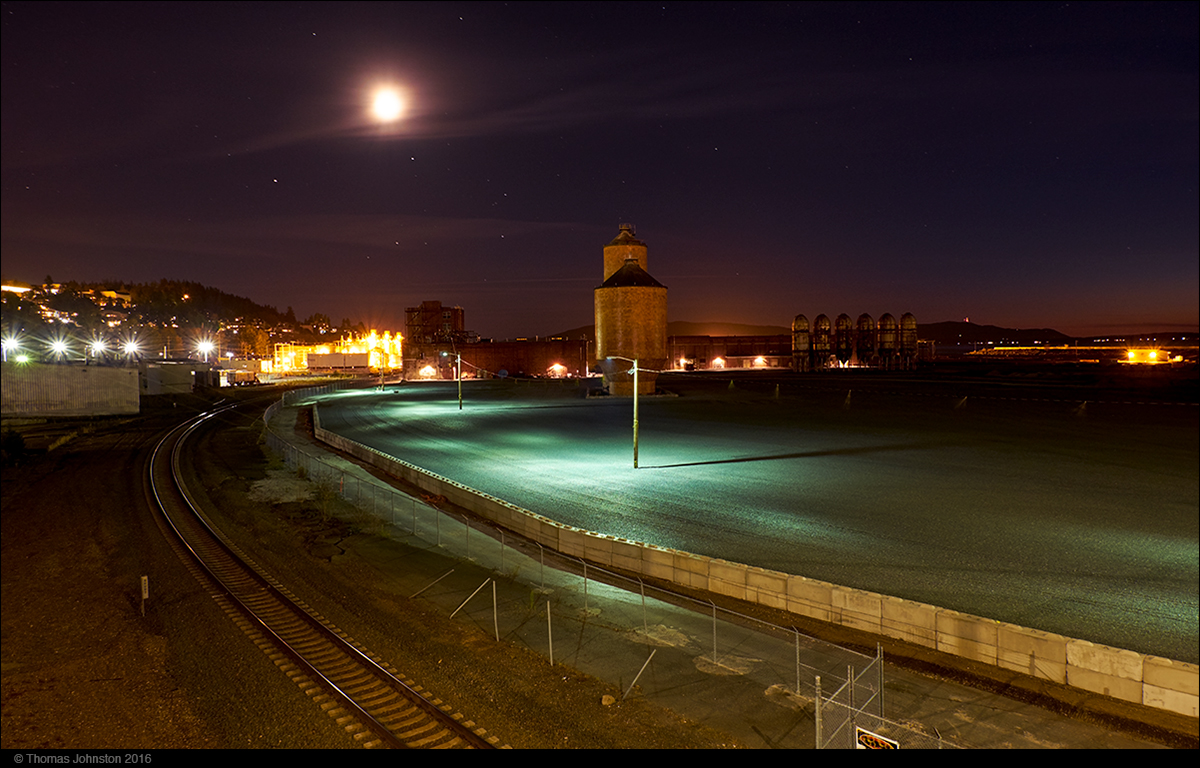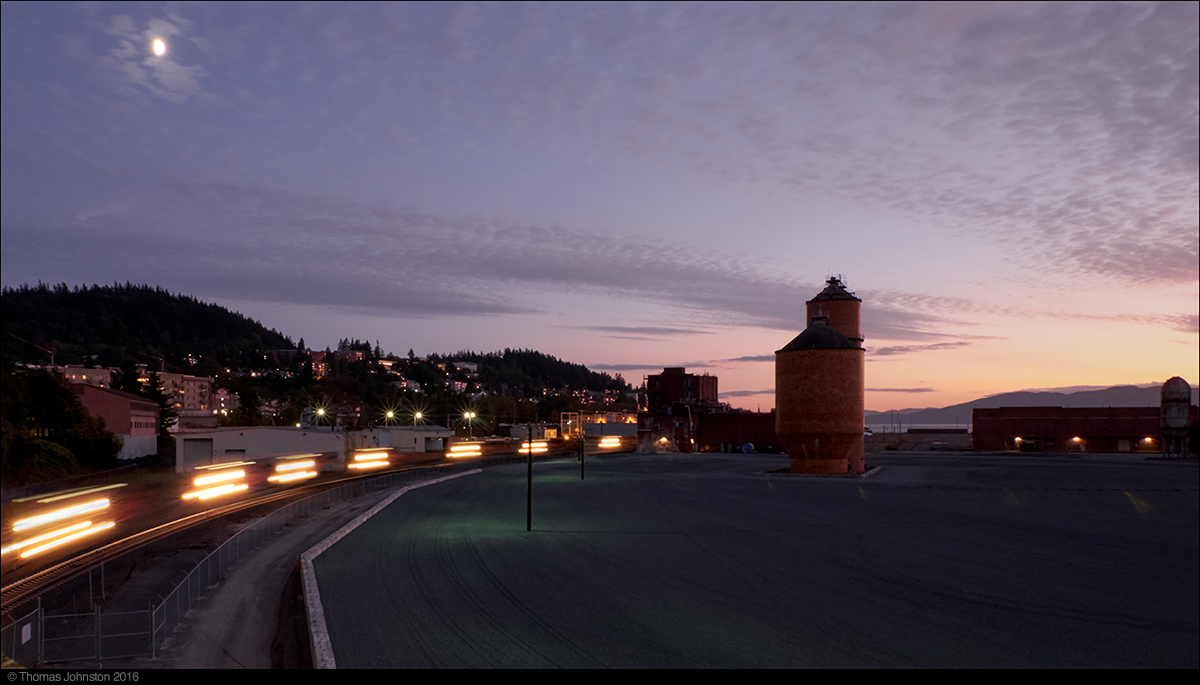
Site of former pulp mill, Bellingham, Washington
At the outset I’d like to say that this post isn’t specifically about art, but it may provide some insight in to how my thought processes, combined with history, experience, and environment, inform my process of making pictures.
One of the first things I ever heard about Bellingham was that it had several beautiful city parks. This was from a couple I knew in grad school who were from Vancouver, B.C. and loved to visit south of the border and had fond memories of the beautifully maintained parks. I was considering a move to the Pacific Northwest and was trying to learn all I could about this then small town of 38,000. I had another friend who had spent several years of her youth there and confirmed the natural beauty but warned of a smell she associated with the town that had remained in her memory.
Eventually I did move north, for a variety of reasons, and Bellingham was my base of operations for many years. Yes, the parks were, and are still beautiful. And yes, there was a unique odor associated with parts of town as a result of the pulp and tissue mill on the 74-acre site on the waterfront in the center of town. I was fortunate to live upwind of the mill for the majority of my years there, but occasionally the wind would shift and remind us of the activities of the mill. There were times when that odor was unbearable to me and I became nauseous, my eyes would burn, and I simply had to avoid the downtown area, especially on the weekends. There were many times I would call the Air Pollution Control Board to report what appeared to be increased activity or high production that would be noticeable after 9:00 p.m. on Friday and throughout the weekend. I never knew if this was indeed a fact. I also remember a story that an unusual discovery was made one Sunday night; a worker investigating a rise in the temperature of chimney #9 found the remains of a human skeleton. The mystery and identity of the individual remains to this day.
During the final decades of operation they built a huge holding pond on the edge of the property, to contain the effluent that previously flowed into the bay. Many locals warned against eating shellfish from nearby waters. If the winds were particularly strong, huge chunks of foam from the pond’s surface would be blown out of the pond, landing in the streets of downtown and neighborhoods in its path. There were a few times when the odor was a threat to human health, when an excess of chlorine gas had been released, and you could see the greenish-orange cloud as it moved through town. Announcements over the radio: stay inside until the cloud has passed.

Coal train at night rumbles through Bellingham, Washington near former pulp mill
In my final few years of living there, negotiations were underway for the mill to close and ownership of the site to transfer to the City or Port of Bellingham. The mill that had begun operations in 1926 closed in 2007, the year after I moved away. On my occasional visits since, I always take note of the progress of the dismantling of this once large industrial complex. Each year more is demolished and taken away in an attempt to prepare the site for its next permutation.
One feature that makes a site attractive to industry is access. In this case, an active railroad line meanders right through it, and thus through the center of town, from north to south. The tracks were used for numerous freight trains on a daily basis, usually signaled by the long 3:30 a.m. blast of the train’s horn as it approached from the northern edge of the town lasting through to its southern exit. There was always local speculation about the enthusiasm of that train’s engineer and the necessity of the daily rousing of the local inhabitants. For many years the Amtrak station saw little use as the schedule for the public was minimal, and as I recall there were some years it didn’t exist at all. At about the time that the Alaska Ferry moved its southern terminal to Bellingham, a new Amtrak station was built in the Fairhaven area and the public schedule increased to two runs each, north and south.
I was reminded of these activities on a recent visit when out taking photographs one night. My friend David F and I have been collaborating on night photography in different locations for many years. He and I went by to see how the landscape of the old mill site was looking, especially as it was a clear, late summer night. The first photo is of the space where the pulp mill stood, and shows a few of the remaining structures. I thought the mercury vapor light and the color it illuminated the ground with was, in this case, appropriate to the content. The second photograph was taken a few nights later when we went again to photograph the light and space; I was inspired by the unannounced arrival of a night train and set about recording its movement for 10 minutes as it rumbled through the site. I was able to change locations and vantage points in my effort to record the movement of the train as a blur using long exposures. During one of the exposures, I realized that what I was seeing was not a passenger train but an industrial freight train, and specifically, the controversial coal train. I was aware of the efforts of community residents and the Lummi Nation that challenged the coal trains and the building of a major terminal at Cherry Point, and I was under the impression that they had been successful in their efforts at defeating this proposal. One can only imagine what the proposed schedule of coal trains running through this community would do, let alone the larger issues of the global environment.

Coal train at night rumbles through Bellingham, Wa. near former pulp mill
With these visits I’m reminded of the changes communities go through, especially as demonstrated here with the population more than doubling. Characteristics of neighborhoods change as once empty tracts of land give way to developments, both residential and commercial. It is exciting to see some of these changes propelled in part by new entrepreneurs filling the needs for residents, retirees, and tourists. While it is reassuring to witness the departure of an environmentally detrimental industry, it was troublesome to see these night shipments of coal passing through the center of town. I witnessed just one freight train, which is one train too many. Cleanup of and transformation of 74 acres of prime waterfront land in the central core is challenging and admirable and has the potential to transform this former waterfront pulp mill site. I am hopeful for the success of the community to rebuild this pristine jewel of a northwest city and let it become an environmental model, recognized for its natural beauty.
reference links: Department of Ecology Coal Train Sierra Club
- Site former pulp mill, Bellingham, Wa.
- Coal train at night rumbles through Bellingham, Washington near former pulp mill
- Coal train at night rumbles through Bellingham, Wa. near former pulp mill




I took a little time to catch up with your recent posts – all beautifully and gracefully composed, and filled with insight and delight. Thanks!
The coal terminal has been essentially defeated. The Army Corps of Engineers accepted the Lummi Tribe’s assertion that it would impact essential fishing grounds protected by treaty rights. All permits have been suspended.
The coal train you saw is headed to the Robert’s Bank terminal in Canada, just over the border. There is one or maybe two a day, whereas the Cherry Point terminal would have required up to 12!